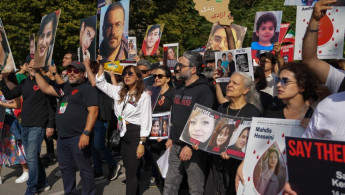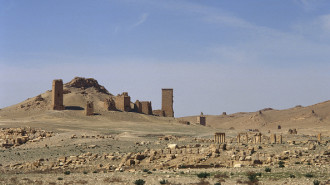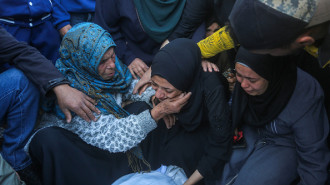'No turning back': Iranian women remain defiant over hijab battle one year after Mahsa Amini's death
Almost 12 months after the death of Mahsa Amini while in Islamic morality police custody, Iran's conservative parliament passed more stringent measures on 20 September against those defying the Islamic Hijab law. Nevertheless, the women The New Arab interviewed remain unwavering in their commitment to the changes they have witnessed since last September.
These women see their defiance of the hijab law as a potent political statement against the theocratic rule in Iran. At the same time, it strengthens bonds among women who stand together in their resistance.
"When I spot young girls on the streets without a hijab or older women with their scarves around their necks instead of their heads, we share a knowing smile—a secret language of encouragement in this fight," explained a 68-year-old housewife from central Tehran, who wishes to remain anonymous for safety reasons.
She said it is not just women who offer support; even passing men salute and applaud their bravery.
"If someone had told me a year ago that women would go about without headscarves today, I couldn't have believed it. But now, it's a common sight in most parts of the city. Everything changed after last year's protests," she added, referring to the anti-establishment demonstrations that swept Iran.
These protests, which were kindled on 16 September by the death of 22-year-old Mahsa Amini, initially focused on the hijab law, but the demonstrations swiftly evolved into a demand for the dismantling of the Islamic regime established after the 1979 revolution.
During the peak of these protests, many women publicly burned their headscarves, and others ventured out uncovered. Despite a brutal government crackdown that claimed over 530 lives, it could no longer coerce women to adhere to the hijab law.
Today, Amini's name has become synonymous with opposition to the establishment for many Iranians.
Elaheh Khosravi, a former journalist, expressed this sentiment in a tweet marking the anniversary of Amini's death: "Around this time last year, I was preparing to visit Kasra Hospital to cope with the grief of Mahsa Amini's loss. I thought I'd be alone, or at best, with a few others. But since that day, we're never alone. We stand united as long as Mahsa Amini is our code name."
'No more fear, no turning back'
However, the defiance of the hijab law in Iran has deep roots that trace back to the ascent of Islamists after the revolution. Last year's protests marked a significant shift in this ongoing struggle.
"The protests were a turning point, inspiring many women to overcome their fears and discard the hijab in public," explains a 25-year-old student. "Before the 'Woman, Life, Freedom' movement, we wore loose hijabs on campus and caps or scarves around our necks in the streets. But now, even on campus, we don't wear hijabs. No matter how harsh the government's laws or punishments, there's no going back from here."
This graduate architecture student also observes a shift in Iranian society. Many who believe in the Islamic hijab no longer seek to impose it on others.
"I recall people, including strangers, asking my mother to ensure I wore a proper hijab when I was a child. In high school, strangers on the street would comment on my loose hijab. But today, it's primarily the Basij plainclothes or people affiliated with the establishment who threaten women without the hijab," she notes.
For older generations, this struggle is nothing new, especially for those who have been involved in political activism for decades.
A 72-year-old activist sentenced to three years in the 1980s for her association with a leftist group opposing the Islamist regime recalls that even wearing lipstick was a form of resistance back then.
"I wasn't big on makeup, but after my release from prison, I proudly wore bright red lipstick everywhere, especially when dealing with government offices. At that time, officials couldn't bear to see a woman wearing makeup. Look at how far we've come," she said.
"If Khomeini knew that women would one day appear in public in Iran as they do now, he might have had a heart attack," she added, referring to the founder of the Islamic Republic of Iran, Ayatollah Ruhollah Khomeini, under whose leadership Islamic Sharia became pervasive in Iranians' lives.
"The government has already lost the battle to enforce the Islamic hijab law," she concluded.




 Follow the Middle East's top stories in English at The New Arab on Google News
Follow the Middle East's top stories in English at The New Arab on Google News

![A group of Palestinians, foreign and Israeli activists gather to participated in an olive picking event on the land in the town of Battir, which is under threat of confiscation by Israel in Bethlehem, occupied West Bank on 8 November 2024. [Getty]](/sites/default/files/styles/image_330x185/public/2182930803.jpeg?h=199d8c1f&itok=__0LgGsa)
